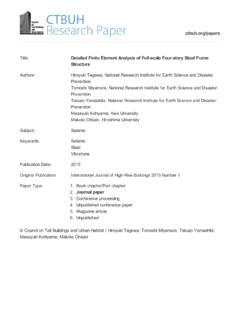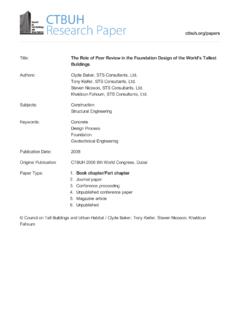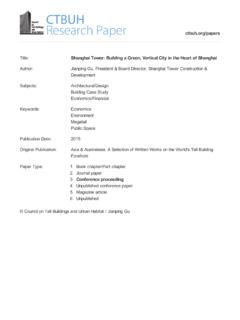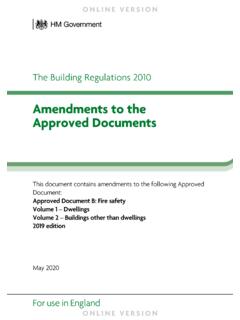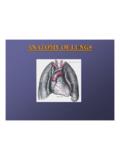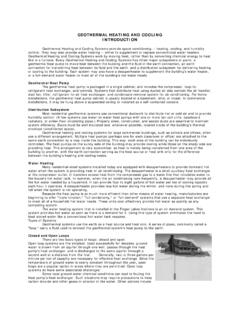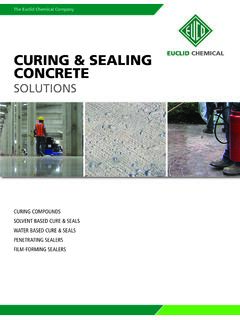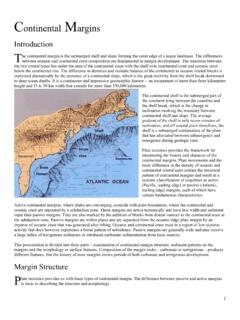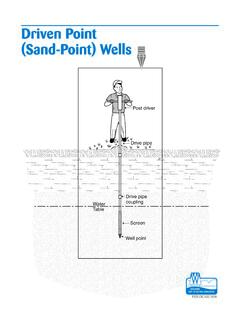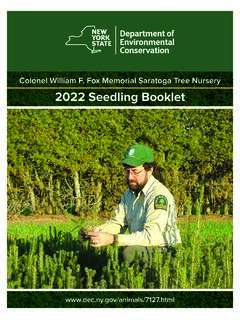Transcription of Structural Design of Taipei 101, the World's Tallest Building
1 Title: Structural Design of Taipei 101, the World's Tallest BuildingAuthors:Dennis Poon, Managing Principal, Thornton TomasettiShaw-Song Shieh, President, Evergreen EngineeringLeonard Joseph, Principal, Thornton TomasettiChing-Chang Chang, Project Manager, Evergreen EngineeringSubjects: Building Case StudyStructural EngineeringKeywords:ConcreteOutriggersSt ructureTuned Mass DamperPublication Date:2004 Original Publication:CTBUH 2004 Seoul ConferencePaper Type:1. Book chapter/Part chapter2. Journal paper3. Conference proceeding4. Unpublished conference paper5. Magazine article6. Unpublished Council on Tall Buildings and Urban Habitat / Dennis Poon; Shaw-Song Shieh; Leonard Joseph; Ching-Chang 2004 October 10~13, Seoul, Korea 271 Structural Design of Taipei 101, the World's Tallest Building Dennis C.
2 K. Poon, PE, , Shaw-song Shieh, PE, SE, , Leonard M. Joseph, PE, SE, , Ching-Chang Chang, PE, SE, 1 Managing Principal, Thornton-Tomasetti Group, New York 2 President, Evergreen Consulting Engineering, Inc., Taipei 3 Principal, Thornton-Tomasetti Group, Irvine, California 4 Project Manager, Evergreen Consulting Engineering, Inc., Taipei Abstract At 101 stories and 508 m above grade, the Taipei 101 tower is the newest World s Tallest Building . Collaboration between architects and engineers satisfied demands of esthetics, real estate economics, construction, occupant comfort in mild-to-moderate winds, and Structural safety in typhoons and earthquakes. Its architectural Design , eight eight-story modules standing atop a tapering base, evokes indigenous jointed bamboo and tiered pagodas.
3 Building shape refinements from wind tunnel studies dramatically reduced accelerations and overturning forces from vortex shedding. The Structural framing system of braced core and multiple outriggers accommodates numerous Building setbacks. A secondary lateral load system of perimeter moment frames and special core connections adds to seismic safety. Column axial stiffness for drift control was made practical through steel boxes filled with high-strength concrete. Occupant comfort is improved by a massive rooftop pendulum Tuned Mass Damper. Pinnacle framing fatigue life is enhanced by a pair of compact spring-driven TMDs. The soft soil subgrade required mat foundations on bored piles, slurry walls, and a mix of top-down and conventional bottom-up construction with cross-lot bracing.
4 The project illustrates the large and small Design decisions in both architecture and engineering necessary to successfully complete a major Building in a challenging environment. Keywords: vortex shedding, high-strength concrete, tuned mass damper, outrigger, fatigue 1. Introduction Every project has a list of challenges, but for Taipei 101, the new world s Tallest Building , that list is longer than size alone would imply. Starting with a Design height of 508 m [check], it also includes the overall and localized load effects from frequent and extreme typhoons; potentially severe earthquakes; and difficult subsurface conditions, including an inactive fault through the site.
5 Occupants must be both physically and psychologically comfortable with the Design , even during high winds and extreme events. Rising from a dramatic, landmark-quality retail mall, the tower has a profile unlike that of any previous skyscraper: a tapering base topped by a series of flared segments. And a couple of temblors rattled the partially-completed structure, reminders of the challenges the Design must address. Meeting all these challenges through studies, Design and construction was an unforgettable experience for all involved. 2. Tower Height The first challenge was the height. Building stories come at an ever-increasing cost, as if the new story is added at the bottom of the Building .
6 That reflects the need for supporting all the floors above, for elevator shaft and stairwell space, and for mechanical, electrical, plumbing and fire protection risers. The economic height limit occurs where the added cost of a floor exceeds the added rent the floor will bring. Prior to Taipei 101, the Tallest Building on the island of Taiwan was the 85-story T&C Tower in Kaohsiung. The major jump in height resulted from the desire of project investors, several financial firms, to occupy space in a landmark Building . Projected office space demand of 200,000 m2 ( million square feet) [check] and individual floor areas based on general office layout standards led to a height of 101 stories.
7 Another 200,000 m2 occurs in a podium of retail space surrounding the tower base and basement parking. 3. Foundations The second challenge was the site. Soft rock occurs beneath 40 to 60 m of clay and stiff colluvial soil. The Design required a 21 m deep basement , while ground water is usually 2 m below grade and potentially at Contact Author: Dennis Poon, PE Managing Principal, Thornton-Tomasetti Group 641 Avenue of the Americas, NY, NY 10011 USA Tel: Fax: e-mail: 272 CTBUH 2004 October 10~13, Seoul, Korea grade. Based on extensive investigations by Taipei -based Sino Geotechnology Inc. and scheduling requirements, five major components were used to create two different foundation systems.
8 One slurry wall m (4 ft) thick surrounds both tower and podium; its 47 m (154 ft) depth cuts off ground water and provides toe embedment well below the to m (72 to 77 ft) excavation depth. Each podium column bears on a single 2 m ( ft) diameter drilled pier. Sockets 5 to 28 m (16 to 92 ft) into bedrock resist net uplift from a podium pressure slab resisting buoyancy. The single-pier Design permitted top down basement construction: a floor was cast to brace perimeter walls, then a story of excavation proceeded below it. Superstructure framing was erected at the same time. As a result, the retail podium opened about a year before the tower topped out.
9 A second slurry wall, enclosing just the tower footprint, was supported by steel cross-lot bracing as excavation proceeded to full depth. the walls were braced to accommodate construction sequencing. A continuous reinforced concrete mat 3 to m (10 to 15 ft) thick transfers load from discrete column and shear wall load points to a distributed pattern of 380 drilled piers, m (5 ft) in diameter, spaced 4 m ( ft) on center in staggered rows to resist gravity loads between and MN (1500 and 2000 kips). Using steel framing minimized Building weight, helping to reduce foundation costs. 4. Building Vertical Shaping The third challenge was the tower shape established by architect Lee.
10 Well-regarded in the region and experienced in tall buildings, including the T&C Tower designed with Evergreen, Lee s Building shape for Taipei 101 provides an instantly recognizable symbol of Taipei and Taiwan. The repeating modules were inspired by the joints of indigenous bamboo and the tiers of pagodas; each module has a narrower base and a wider top as if a flower opening to the sky. Each module has eight floors, and eight modules form the majority of the tower s height. In the Chinese spoken in Taiwan, eight is a homonym with wealth, making it a very appropriate feature for a financial center. A ninth module that tops the main shaft and supports an architectural spire has a smaller footprint but matching wall slopes.
